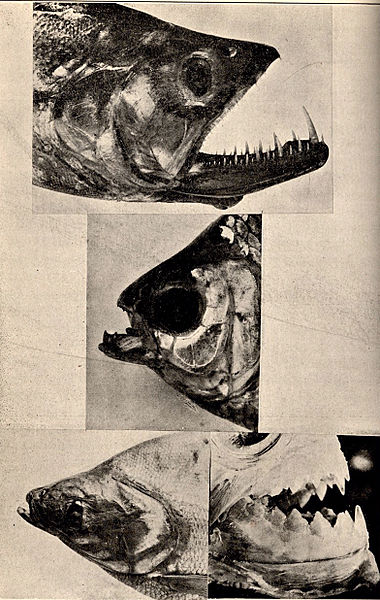File:FMIB 52291 Adaptive Radiation in the Characinide The central figure of Atygnax bimaculatus with notched teeth probably represents the more.jpeg

Original file (783 × 1,236 pixels, file size: 484 KB, MIME type: image/jpeg)
Captions
Captions
Summary edit
| Author |
creator QS:P170,Q66573 |
|||||||||||||||||||||||
| Description |
Adaptive Radiation in the Characinidæ. The central figure of Astyanax bimaculatus with notched teeth probably represents the more primitive condition. The lower left hand figure represents Anodus latior (=Potamorhina latior) with no teeth and a very long alimentary canal, a mud eater. The lower right-hand figure represents the scissor-like jaw and teeth of Serrasalmus humeralis whose relatives have been repeatedly reported to have killed bathers before they could reach shore after being attacked. The upper figure represents Raphiodon vulpinus Spix which has reached the extreme in conical teeth, the large canines protruding above when the jaws are closed. The over 100 South American genera and 500 species of this family offer pretty complete series from the center to the extremes with many lateral branches. English: Adaptive Radiation in the Characinide. The central figure of Atygnax bimaculatus with notched teeth probably represents the more primitive condition. The lower lefthand figure represents Anodus latior with no teeth and a very long alimentary canal, a mud eater. The lower right-hand figure represents the scissor-like jaw and teeth of Serrasaima humeralis whose relatives have been repeatedly reported to have killed bathers before they could reach shore after being attacked. The upper figure represents Raphiodon vulpinus Spix which has reached the extreme in conical teeth, the large canines protruding above when the jaws are closed. The over 100 South American genera and 500 species of this family offer pretty complete series from the center to the txtremes with many lateral branches
|
|||||||||||||||||||||||
| Date |
1906 date QS:P571,+1906-00-00T00:00:00Z/9 |
|||||||||||||||||||||||
| Collection |
institution QS:P195,Q219563 |
|||||||||||||||||||||||
| Current location |
English: Freshwater and Marine Image Bank |
|||||||||||||||||||||||
| Accession number | ||||||||||||||||||||||||
| Source/Photographer |
English: Eigenmann, Carl H. Fresh-Water Fishes of North and Middle America, Popular Science Monthly, June, 1906, p. 524 |
|||||||||||||||||||||||
| Permission (Reusing this file) |
|
|||||||||||||||||||||||
File history
Click on a date/time to view the file as it appeared at that time.
| Date/Time | Thumbnail | Dimensions | User | Comment | |
|---|---|---|---|---|---|
| current | 06:13, 11 September 2015 |  | 783 × 1,236 (484 KB) | BMacZeroBot (talk | contribs) |
You cannot overwrite this file.
